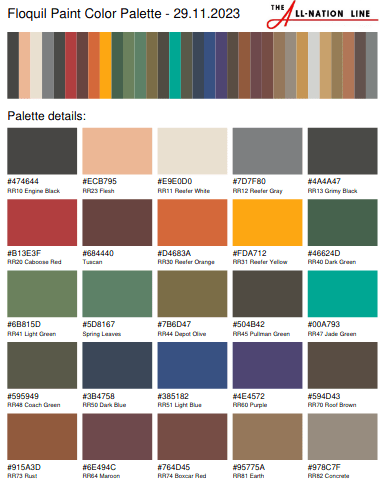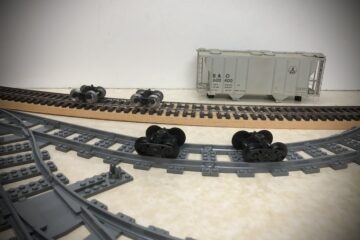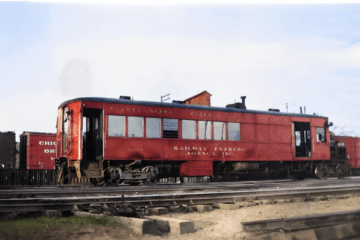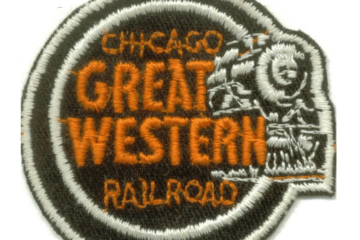Paint: A key multi-variable aspect for finishing out models.
When building a model, have you ever had a prototype color that you just could not match to the current available paints in the store? When my Grandfather lived in Chicago, he sometimes had the luxury of visiting with the fellows in the railroad paint shops to get paints used on the actual prototypes, taking his models down to the actual place where they painted the real trains. So for example, finding that he couldn’t get the exact shades from hobby shop bottle mix, Grandpa Les took his traction models to the Chicago Surface Lines‘ paint shop. The working men there gave him the colors he needed to either spray or hand paint his model train into the standard colors used for the appropriate street car model! Now that was truly matching the color! Most of us don’t have access to the “real thing” so we have to do the best we can with color charts and mixes.
Since the 1940s, modelers typically used paint brands called “Floquil” or “Scalecoat” or “Testors” or “Patra”. As an example, Floquil matched the various colors we needed to finish off our models; however, in ~2013 the model railroad colors were no longer offered by the manufacturer. Modelers started gathering as much of the paint as they could find; however, those days of getting the old Floquil bottles are numbered, because even if the bottles can be found the paints dry up overtime.
 With the help of historical paint reference documentation and modern technology, All Nation Line is developing color palettes to help the modeler choose or figure out the exact mix of paints to match the model to the prototype. We have not found similar comparisons between the historical colors in the brands and what is available today. Thus, these newly created references may be just what you need! Choosing the right color may be as simple as selecting a prepared bottle from a vendor that is an exact match. Or, it may be more complicated in terms of mixing formulas to derive the matching color needed as used on the prototype.
With the help of historical paint reference documentation and modern technology, All Nation Line is developing color palettes to help the modeler choose or figure out the exact mix of paints to match the model to the prototype. We have not found similar comparisons between the historical colors in the brands and what is available today. Thus, these newly created references may be just what you need! Choosing the right color may be as simple as selecting a prepared bottle from a vendor that is an exact match. Or, it may be more complicated in terms of mixing formulas to derive the matching color needed as used on the prototype.
We added a new category in our “Cool-Info” Helpful Hints documentation section for you to reference these paint palettes. In time we will add more documentation and color palettes for cross-referencing purposes to aid modelers with comparative choices. As time permits, we will be developing these color palettes for various brands of model paint or even for the color schemes used by various railroads.
So how do you use this new found information? Take a look at our section of reference documents: Paint Reference Documents. There you will find reference documents and various color palettes (Floquil, Tamiya, Lionel Trains, Testors, Union Pacific Railroad Colors) that we developed with the assistance of available technology. As an example, you will see several palettes like this Floquil palette.
In addition, we have had discussions with AK Interactive which has model paints and they, too, have within their palette of available colors ones which maybe an equivalent to the Floquil colors.
As is the case when going to the paint store, color selection is done with the help of paint chips whether that is for a visual flavor or if you are trying to match a color to an existing shade. In the case of color palettes as displayed in the web browser, you may note that the color on the screen may not perfectly match a paint chip at hand. There is a good deal of technical information regarding the support of colors in software applications, web sites and browsers that certainly can get into a deep discussion including video hardware and device drivers. For our purposes here with regard to the palettes given in our Modeling Category, a perfect match to a color coming out of a bucket of paint is not guaranteed. It may be close enough though to assist you in making a choice of paints to be used on a model. To make that exact color we are looking for we need the exact numbers (Red, Green & Blue (RBG) -primary color numbers) to then mix to the color we need. The explanation for why a color does not seem just right as displayed on your screen and how to mix is for a blog post on another day.
But to make this long story short, below are 2 examples from my spreadsheet about 2 well known Floquil colors. Engine Black and Grimy Black. In the first example, the Engine Black has the RGB values and an estimated mix formula that could be tried using other brands of paints.
In the 2nd example for Grimy Black, the AK Interactive Gun Metal is a close RGB match. However, the mix formula is very different.
Of course your best option is if a hobby brand of model paint has already a pre-determined color for you specific model such as a Tuscan shade for a CGW engine, then go with that. In any regard, painting is another fun part of model railroading.






